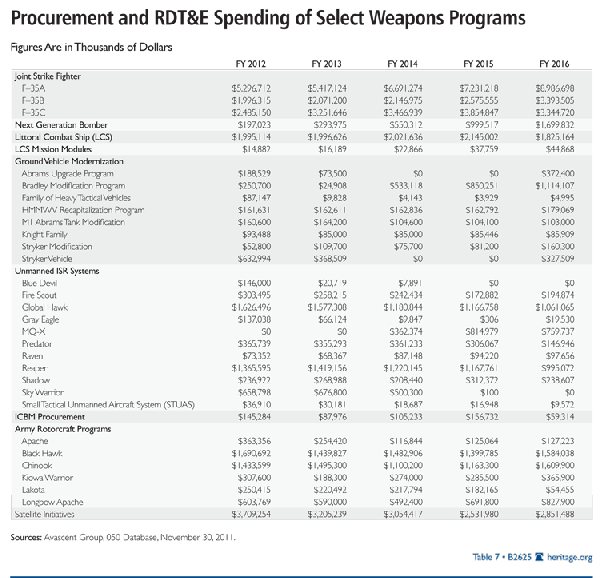Abstract: The Budget Control Act, which ended the impasse over the debt ceiling and created a Super Committee to identify more deficit reduction proposals, cuts the defense budget by $1 trillion and paves the way for further reductions next year. These cuts come on top of successive rounds of deep cuts in defense dollars and capabilities that Congress and the Obama Administration have already implemented. With the failure of the Super Committee, the defense budget will face continued uncertainty and steeper reductions. Such deep reductions not tied to meaningful strategic planning threaten to undermine U.S. power and influence around the world and reduce the ability of the military to meet future threats. Rather than let arbitrary budget goals drive defense strategy, Congress should base defense spending on U.S. national interests and the need to defend against increasing global challenges.
U.S. financial solvency has consumed the attention of Congress and the Obama Administration. Most conservatives believe that reducing federal spending, debt, and deficits are intrinsically linked to the revival of the economy. Not surprisingly, the current leadership in Washington has targeted the Department of Defense (DOD) budget in efforts to reduce federal spending.
To resolve the recent impasse over the debt ceiling, Congress passed the Budget Control Act of 2011 (BCA), which created a legal framework that would drastically cut the defense budget even further. The bill defines the dollar amount to be cut from the defense budget but fails to answer the exceedingly important question of what would be cut from military plans and programs. Proposals to that effect have come from the President’s commission, congressional offices, and various Washington-based organizations, but few have originated in the Pentagon, although just recently Secretary of Defense Leon Panetta outlined the impact of sequestration in a letter to Congress.
While defense leaders are conducting yet another strategic review to inform this latest round of budget cuts, the two processes are operating in tandem according to testimony by General Martin E. Dempsey, current chairman of the Joint Chiefs of Staff. Policymakers should start identifying the plans and programs that will be most affected by the next two years of reductions in defense spending. Congress should then use the review of roles and missions to evaluate the risk and consequences of each decision to better inform their decisions on the forthcoming fiscal year (FY) 2013 defense budget request.
Strategy Is Chasing Down the Defense Budget
DOD leaders are currently conducting a strategic review of defense roles and missions to guide Congress in determining future acceptable cuts. The first flaw in this approach is that the defense budget has already been cut and is being cut before this latest strategic review will be completed. This means that military and defense officials are chasing budget numbers that have been determined in a vacuum and attempting to identify a strategy to match. It also creates a debilitating state of seemingly endless strategic review by Pentagon leaders that only compounds the challenges posed when strategy changes faster than force structure.
Further, the latest defense strategy is ignoring global realities to meet budget targets. The military is a vital tool of U.S. foreign policy. Slashing defense spending without any reduction in U.S. foreign policy commitments around the world is not only dangerous, but also more costly in the long run than maintaining stable defense budgets. A review of roles and missions will not change U.S. foreign policy; only the President can do that. Starving the military as part of a deficit reduction plan may cost taxpayers more in the future if it makes the country less safe and increases the risk of another terrorist attack or the likelihood of U.S. forces being drawn into yet another overseas mission.
The only responsible way to fund defense is to identify the nation’s vital national interests, ask what is required to defend the nation and those interests, determine what military capabilities are required to do so, and then build a defense budget to match the foreign and defense policies of the United States. Identifying defense cuts and then trying to squeeze them under a strategy that remains unchanged in reality means the U.S. military will be forced to do more but to do it less well.
Nonetheless, in anticipation of the defense review scheduled to be released soon, some general assumptions can be made about what military initiatives will most likely be sacrificed.
Sweeping Defense Cuts Already Underway
Serious efforts to reduce spending started in April 2009 when President Obama canceled or delayed more than 50 major weapons programs. Two years ago, the Obama Administration and Congress began to reshape the U.S. military by changing the direction of defense investments and canceling programs with a total lifetime value of more than $300 billion.
The list of cancelled programs includes a combat search and rescue helicopter; the F-22 fifth-generation fighter; the Army’s Future Combat Systems (primarily a networked ground vehicle program); the multiple-kill vehicle for missile defense; a bomber for the Air Force; the VH-71 presidential helicopter; a transformational satellite program; and the second airborne laser aircraft. In addition, the Administration decided to extend the construction of an aircraft carrier from four years to five years, reduce the number of ground-based midcourse missile defense interceptors from 44 to 30, and abandon the Navy’s next-generation cruiser.
The Administration also took an ax to the FY 2011 defense budget. Some of the reductions include ending production of the C-17, the country’s only wide-bodied cargo aircraft; terminating the EPX intelligence aircraft; permanently canceling the Navy’s next-generation cruiser; ending a satellite program; and killing the Marine Corps’ expeditionary fighting vehicle program. The Army’s surface-to-air missile program and its non–line-of-sight cannon were also eliminated.
The defense reductions continued in April 2010 when Secretary Gates announced a cost savings initiative of roughly $101 billion over five years. This included reducing the number of contractors and civilian personnel, consolidating duplicative infrastructure and facilities, and cutting funding for contractors in intelligence.
Next, the White House budget office told the military to reduce its budget by another $78 billion[1] through “management and acquisition reforms” as part of the Administration’s FY 2012 through FY 2016 defense budget, which arrived on Capitol Hill in February. President Obama followed with a call to reduce defense spending by $400 billion over 13 years. Meanwhile, Members of Congress and organizations around Washington, D.C., developed their own plans for cutting defense spending.
Today, the military is absorbing the cuts in the Budget Control Act of 2011 and confronting the specter of many more cuts over the next 10 years. The legislation does not define one set amount by which to cut spending, but instead sets forth several scenarios. Secretary of Defense Panetta recently detailed what DOD programs would be cut under full sequestration in response to a query from Senators John McCain and Lindsey Graham. The majority of cuts would come from equipment and weapon systems: Joint Strike Fighter, P-8 aircraft, ground combat vehicle, and ships.[2]
Budget Control Act’s Details on Defense
The Budget Control Act of 2011 reduces the deficit by setting discretionary spending caps for the next 10 years and requiring Congress to reduce the deficit by an additional $1.2 trillion to $1.5 trillion. The legislation does not spell out DOD dollar amounts, nor does it identify specific line items for cuts. Instead, the Budget Control Act creates several potential scenarios that would reduce defense budget toplines.
The law specifies two stages of spending cuts: (1) initial discretionary caps from FY 2012 to FY 2021, and (2) an additional reduction of $1.2 trillion to $1.5 trillion over 10 years through either a plan by the Super Committee or through sequestration. Because the Super Committee failed to provide legislation by the deadline, the cuts will be automatically implemented through sequestration.[3]
Discretionary Caps. The first stage cuts federal spending through discretionary caps passed in the Budget Control Act. The caps will limit federal discretionary spending (non-mandatory or appropriated spending) over the next 10 years by setting a maximum limit that Congress can appropriate each year. These discretionary caps are considered budget cuts because they are lower than current and future discretionary budget requests. For FY 2012, the caps require cuts totaling about $6.5 billion compared with FY 2011 enacted levels. In subsequent years, the caps limit spending growth to less than inflation, in amounts ranging from 0.4 percent to 2.2 percent. The discretionary caps delineate only between security and non-security; thus, Congress will have decide how much each department will receive under these limits.
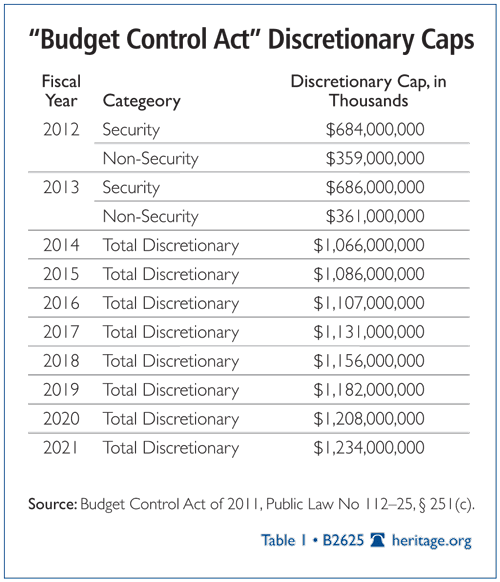
Under these discretionary caps, it is possible to estimate what would have been the new toplines for the defense budget. The bill creates separate caps between security and non-security spending for FY 2012 and FY 2013. The security spending is defined as the budgets for the DOD; the Department of Homeland Security (DHS); the Department of Veterans Affairs (VA); the National Nuclear Security Administration (NNSA); the intelligence community management function; and international affairs.[4] The President’s FY 2012 budget requested $717 billion for these departments and agencies. This is $33 billion more than the discretionary cap set by the Budget Control Act.
Assuming the $33 billion in cuts is divided proportionally among the departments, except for the VA, which President Obama recently stated was off the table,[5] then the DOD budget for FY 2012 would be approximately $523 billion[6]—$30 billion less than the $553 billion request.
If the FY 2013 defense budget is cut by the same proportion, then the DOD will receive $524.7 billion—a $45.9 billion reduction. While the Office of Management and Budget (OMB) calculates that the discretionary caps will cut DOD spending by approximately $330 billion over the 10 years, the DOD states that the cuts will be closer to $460 billion.[7] The discrepancy is due to different starting baselines. The OMB uses the CBO baseline, which is lower than DOD’s figures. (See Table 2.)

These cuts are applied to the pending FY 2012 budget request, which already includes many of Secretary Gates’s cuts and cost-saving efforts. More important, the FY 2012 budget request eliminates real growth in defense spending after FY 2015. In other words, if zero growth through FY 2021 is assumed, then the $460 billion will be real cuts, not just slowed growth in defense spending.
The discretionary caps are affecting the pending FY 2012 defense spending bills immediately. Although DOD is currently operating on another continuing resolution (CR), both the House and Senate have taken up Department of Defense appropriations bills for FY 2012. The House-passed bill provides $530 billion in base budget authority (excluding war spending), which is about $17 billion above 2011 but $9 billion less than the President’s request. The Senate bill, passed by the Appropriations Committee and pending floor action, provides $513 billion, a freeze at the 2011 level, which is $25.9 billion less than the President’s FY 2012 request. The Senate Committee on Appropriations plans to achieve those cuts largely by freezing production of the Joint Strike Fighter to FY 2011 levels, cancelling the Joint Light Tactical Vehicle, reducing acquisition of the Ground Combat Vehicle, and reducing the ground aspect of Joint Tactical Radio Systems.[8]
It should also be noted that under House bills considered or passed to date, preliminary estimates indicate they may exceed the Budget Control Act “security” cap by about $9 billion. If so, it would force reductions that could further trim defense spending.
A “sequestration” (automatic spending cuts) may occur in January 2012 under section 251 of the Balanced Budget and Emergency Deficit Control Act as amended by the BCA if appropriations for 2012 breach the discretionary spending limits for 2012 set in the BCA. This would put yet more downward pressure on the defense budget.
Super Committee and “Sequestration.” The second stage of the Budget Control Act will take effect four months into fiscal year 2013 and reduces the deficit by $1.2 trillion or more. The Super Committee had the opportunity to provide legislation that would have cut $1.2 trillion from the deficit. However, members failed to provide a plan to Congress by the deadline, thus triggering the automatic cuts, known as sequestration. Officially the reductions are split evenly between defense and non-defense, but the division is hugely unbalanced. The sequestration will impose:
- New spending limits. While the total dollar amounts are the same, the spending limits for sequestration differentiate between security and non-security spending for all 10 years.
- A new definition of security. Security is narrowly limited to just Budget Function 050 spending, meaning the Department of Defense and a small amount of defense-related funding through the Department of Energy. The DOD budget comprises roughly 95 percent of 050 spending.
- Annual reductions. The annual reductionswill be divided evenly between the security (defense) and non-security categories—50 percent from each.
- Mandatory spending. The non-security category includes mandatory entitlement spending, but with very large exceptions. Many programs are exempt from the automatic reductions, excluding roughly 70 percent of entitlement spending from the cuts. In addition, reductions in Medicare cannot exceed 2 percent of that program’s spending. The result is that defense, which is about one-fifth of the total budget, absorbs the largest cuts each year.
Thus through sequestration, DOD will absorb roughly 95 percent of the security cuts and nearly 48 percent of the total cuts. The FY 2013 discretionary defense budget will be cut automatically by $98.4 billion. (See Table 3.)
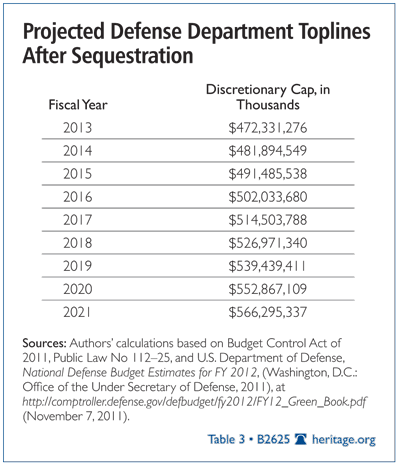

The actual defense spending reductions will total approximately $1 trillion through FY 2021 when measured against the President’s FY 2012 defense budget request; $460 billion through the initial discretionary caps and about $500 billion through sequestration. Secretary Panetta has strongly stated that cuts of this magnitude will be “devastating”[9] for many reasons, including the potential to hurt war efforts, the likelihood of job loss by government and contracting personnel, and the lack of flexibility imposed by the law.
Largely due to the dangerous impact these cuts would have on national defense, some Republican Senators already have said publicly they would move to reject the trigger procedure before it took effect. But even if the dangerous trigger procedure were overcome, which is unlikely given President Obama’s threat to veto any bill that overturns sequestration, many in Congress will still consider DOD a cash cow to fund domestic programs.
Implementations of the Cuts
Cuts made to military plans and programs should follow a strategy that includes prioritizing objectives and capabilities. However, in the past proposals to reduce defense spending have done so by salami-slicing the defense budget with little guidance for defense strategy or U.S. national security. These suggestions are often justified by citing of individual programs and their cost overruns or inefficiencies. However, these simplistic proposals to cancel weapon systems often ignore that the federal government has been the source of these problems in many cases.
As noted, Pentagon leaders are currently drafting another strategic review to inform the latest round of budget cuts. This will not be of any help in the current fiscal year, 2012, or even FY 2013 if Congress does not act responsibly. If spending in FY 2012 exceeds the discretionary cap set in the BCA, an automatic cut will occur. This cut will be applied proportionally to every account in defense (the President has the option of exempting military personnel, which many expect he would choose).[10] Starting in January 2013, when the sequestration is triggered, the cuts again will be applied to every account proportionally.[11] From FY 2014 onward, the spending cuts will be applied to the Department of Defense toplines. If cuts are done in this manner, it would be extremely detrimental to defense spending, making many procurement programs “unexecutable.”[12] Not only is this damaging to defense capabilities, it is entirely wasteful and irresponsible.
If Congress allows DOD to have some flexibility in implementing sequestration, as Secretary Panetta is basically requesting, it would allow him to employ some level of strategic planning behind the massive change in long-standing military size and posture.[13] While most weapons systems and equipment programs will be impacted by the sequestration, some priorities are expected to emerge from the ongoing strategic review.
Unfortunately, many in Congress—even those who understand the vital importance of a strong national defense—incorrectly view the deep cuts to defense as part of sequestration as a problem that is a long way off and can be dealt with later because the cuts do not take legal effect for over one year. As a practical matter, however, some consequential sequestration cuts will be felt nearly immediately. Managers of defense programs must begin right now adjusting their plans in light of their expectations of deep cuts in January 2013. Vendors and suppliers, many of them small businesses across America, who provide contractors long-lead items for major platforms will not receive orders as planned due to ongoing uncertainty about funding levels. Those who lead companies and workforces as part of the defense industrial base will accelerate plans to consolidate, merge, or exit the defense business altogether as the budget stalls out until after the presidential election. Civilians who work for the Department of Defense and may be furloughed will require notification time and other process delays that will also have to begin very soon whether or not sequestration is repealed or ignored over the next year.
Also, the looming threat of sequestration virtually guarantees Congress will instead seek to fund defense through a long-term continuing resolution in fiscal year 2013, which creates another host of serious problems borne uniquely by those in uniform. This is no surprise since Congress has been funding the military at war through a series of short-term continuing resolutions on and off for the past two years. And the negative effects have been tremendous, not to mention costly and inefficient. For starters, continuing resolution spending bills restrict the military from being able to start new program contracts or expand existing programs. When men and women are in combat overseas, it is shameful policy. During the 2011 budget standoff, Army officials lacked funds to purchase four new helicopters that are employed extensively in overseas operations in Afghanistan. Under the spending constraints, the service was unable to buy four new CH-47 Chinook helicopters for the Army’s 13th Combat Aviation Brigade. The Air Force could not double production of the MQ-9 Reaper drone from 24 to 48 aircraft needed by troops on the ground under last year’s continuing resolution rules. The CR also forced all of the military services to confront a “bow wave” of deferred aircraft, ship, and vehicle repairs, as well as facility maintenance.
The defense spending sequestration of January 2013 has adverse effects now on the nation’s defense capabilities. The fact that the “trigger” may never technically be pulled will not save defense from absorbing tremendous consequences as a result of the chaos of uncertainty in plans and funding levels for another year and one-half.
Guiding Strategy. The new strategic review will be published roughly one year after the 2010 Quadrennial Defense Review (QDR) and three years after the Quadrennial Roles and Missions Review Report. The short time between these major documents does not lend itself to major changes, especially given that they will still be using the same National Security Strategy as guidance.
This latest review process has only two noticeable differences:
- The fact that DOD is operating under strict budget constraints when translating stated roles into capabilities, and
- The drawdown of personnel in Iraq and Afghanistan.
The 2010 QDR identifies four priority objectives:
- Prevail in today’s wars,
- Prevent and deter conflict,
- Prepare to defeat adversaries and succeed in a wide range of contingencies, and
- Preserve and enhance the volunteer force.
Assuming the new Secretary of Defense does not seek to concede the U.S. leadership role in the world, the latter three are unlikely to change. The first objective, prevailing in today’s wars, will most likely undergo the greatest spending adjustments. The Army and Marine Corps already bear a portion of the cuts in terms of size and force structure, but they would have to shrink further under sequestration.
Development of AirSea Battle, a new operational concept, will also significantly affect the services’ investment portfolios. Per the 2010 QDR, the Air Force, the Navy, and now the Marine Corps have been developing this concept to counter the anti-access capabilities being fielded by other countries, mainly China. In other words, AirSea Battle is a plan to overcome China’s growing capability to deny the U.S. military access to the Western Pacific region and, if needed, win a prolonged conflict. In essence, AirSea Battle is intended to guarantee the U.S. and others freedom of access.
Given that AirSea Battle is meant to address rising threats and limits duplicative resources by touting “jointness” and cross-service cooperation, it will likely drive future Air Force and Navy research, development, and procurement. However, it is unlikely that the AirSea Battle concept of operations will resemble the one authored by the Center for Strategic and Budgetary Assessments;[14] nor is it likely that it will remain narrowly focused on the initial challenges of China’s growing technological advantages and anti-access capabilities. Due to budget pressures, the AirSea Battle concept is at risk for becoming a catch-all justification for weapons programs that the services do not want cut.
The Pentagon’s strategic review meant to guide the latest round of budget cuts would drive one to assume that the spending reductions will not be divided equally among the services. Traditionally, the Navy, Army, and Air Force have each received about one-third of the resources. Given the budget environment, this will probably not continue. Instead, recent emphasis on Asia and the Pacific Rim by Secretary Panetta and Secretary of State Hillary Clinton indicates that the Air Force and Navy would bear a smaller portion of the cuts. However, this is relative because the Air Force and Navy have largely been bill-payers for the Army over the past decade as the ground forces largely prosecuted operations in Iraq and Afghanistan.
Applying the Cuts. Ongoing defense cuts will be spread among the four major accounts: research, development, test, and evaluation (RDT&E); procurement; military personnel; and operations and maintenance (O&M). The majority of spending cuts will come from the military’s modernization accounts: RDT&E and procurement.
RDT&E. The RDT&E account is the smallest of the four DOD accounts, totaling $80 billion in FY 2010. Most program elements are small (tens of millions of dollars). Larger RDT&E programs (more than $100 million) are tied to major programs, such as platforms, satellites, missile defense, and weapons development. Any RDT&E program tied to a terminated procurement program will be cut. In addition, the RDT&E account will likely be reduced by an overall percentage resulting in the cancellation of smaller, technically unproven projects
Any program that cannot demonstrate some sort of “payoff” within the five-year defense budget plan is at risk for cancellation or truncation. An example of a research program at risk is directed energy. The technological advancements in directed energy have been slow.

Procurement. The procurement account is often cut first, partly because procurement programs are often more visible, expensive, and over-budget. During past periods of defense reductions, Congress has tended to cut procurement and maintain current U.S. inventories. However, calculating savings from procurement cuts is difficult. The defense budget only provides information five years into the future, known as the Future Years Defense Program. Thus, any mentioned savings from procurement programs will be confined to the five-year cycle (except for shipbuilding) and therefore the cuts will occur in the first few years of the nine-year sequestration cycle.
Another obstacle to calculating actual savings from procurement cuts is that procurement contracts are often awarded over several years. Prematurely terminating a contract does not save money immediately because the savings from reduced acquisition occur after current contracts are fulfilled, often several years in the future. Indeed, termination of some contracts may not save money at all as costs of termination may exceed the costs of completion.
Finally, calculating unit cost is often difficult. When the Pentagon lowers the number of purchases per year and extends the buy schedule, it increases unit costs, program management costs, and other associated costs. Thus, although this paper uses an average unit cost, prolonging the buy schedule makes calculating future costs difficult and reduces the budget less than might be expected.
Despite this, many procurement programs will likely be cancelled or reduced. Secretary Panetta recently stated that half of the cuts will come from weapons programs.[15] In his letter to Senators John McCain and Lindsey Graham, Secretary Panetta provided a list of weapons systems that would have to be cancelled due to sequestration. (See Table 7.)
Other programs at risk for cuts due to the drawdown in Operation Iraqi Freedom and Operation Enduring Freedom are:
- Expansion of the AC-130 fleet. [16] Due to high demand in Iraq and Afghanistan, the Pentagon is planning to increase the AC-130 fleet from 25 to 33 in FY 2012.[17] The plan is to convert 16 new C-130Js into gunships to replace retiring AC-130s and expand the fleet by eight. Limiting procurement to just replacing retiring gunships would save $722 million.

- MV-22 Osprey. The initial problems in development, since overcome, still make the Osprey a target. Each Osprey from FY 2012 to FY 2016 will cost an estimated $81 million. Reducing procurement by three Ospreys per year from FY 2012 to FY 2016 would cut spending by $927 million.

The top priorities for the Air Force and Navy will likely be projecting power and maintaining global presence and access in an environment of increasing and evolving threats, including those specifically aimed at denying the U.S. access to certain areas of the world. AirSea Battle will be the driving concept behind future investment decisions.
Although AirSea Battle has not been completed, the QDR emphasizes certain functions that are key in defeating an anti-access adversary. These capabilities include improving subsurface operations and long-range strike capabilities. The QDR specifically mentions the importance of the Virginia-class submarines.[18] Not surprisingly, the Secretary listed the SSBN(X) and the Littoral Combat Ship as programs likely to be canceled or truncated. Another ship program that could be killed is the Joint High Speed Vessel.
- Joint High Speed Vessel. According to the five-year shipbuilding plan, the Navy will buy eight ships at $194 million per ship through 2016, while the Army will purchase one in FY 2012.[19] This new class of ship was introduced in 2009. However, when weighed against other priorities, the Navy may prefer to spend more on submarines and destroyers.
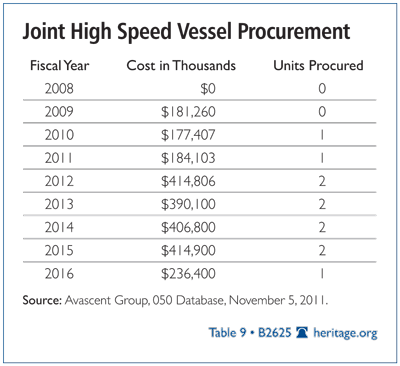
Lastly, there are large programs in command, control, and communications (C3) that could be eliminated as a result of sequestration.
- Joint Tactical Radio System (JTRS). The Joint Tactical Radio System is intended to provide interoperable communications across all the services, but the program has suffered from technological difficulties and delays. The Army cancelled the Ground Mobile Radio, the tactical ground portion of the program, last month.[20] For now, the airborne portion of JTRS still exists.
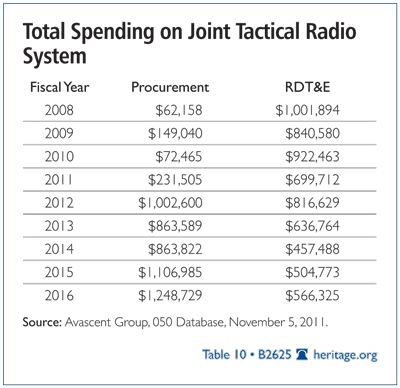
Cancelling all of these programs would save about $110 billion from FY 2013 to FY 2016. Clearly, this only accounts for a fraction of the trillion-dollar cut thereby placing a greater burden on the RDT&E, personnel, and O&M accounts.
Cutting procurement will also be less productive because the military has been largely on a procurement holiday regarding the purchase of next-generation systems, which has resulted in an aging inventory. Cutting procurement also forces the military to invest more in the maintenance and upgrades for current platforms. Thus, any cuts in procurement will increase cost pressures in the O&M account, which is harder to predict, manage, and reduce smartly.
Canceling procurement programs does not recover sunk costs. Prior to the acquisition of weapons systems, the Department of Defense invests in initial research and development programs. Today, the RDT&E proportion of the costs for each program is much higher than before. The Center for Strategic and Budgetary Assessments reports that the current procurement-to-RDT&E ratio is 1.4 to 1, compared to 3.5 to 1 in the 1980s.[21] Since 2001, DOD has incurred approximately $46 billion in sunk costs from cancelled procurement programs.[22] Cancelling future procurement programs will create the same situation for their sunk costs.
Finally, canceling weapons systems also costs money up front, something largely overlooked in budget drills as severe as sequestration and on Capitol Hill. In many cases, the government owes contractors reimbursement for costs incurred and for premature contract termination. According to the Government Accountability Office, “when the government terminates a contract for convenience, it must compensate the contractor for the incurred costs on the completed work, a fee or profit on that work, and the termination costs.”[23]
Military Personnel. One primary way defense officials are planning to save money is by reducing the number of active-duty service members, mostly from the ground forces. Lieutenant General Thomas P. Bostick, Army service personnel chief, recently indicated that budget cuts will force the service to consider cutting large numbers of brigade combat teams. The latest draft of the Pentagon’s FY 2013 budget request reportedly proposes moving up to six heavy armor BCTs from the Active Component to the Reserve Component. Army leaders are considering cutting the number of soldiers “in various ways, including buyouts, voluntary and involuntary separations and retirements, to bring the total to 520,400 active duty soldiers by September 30, 2016.”[24] The Marine Corps is facing the same choices in reducing size, dropping below the suggested 186,800.
However, cutting force size will not generate the level of long-term savings achieved in previous defense build-downs because personnel costs have grown exponentially in the past decade as the all-volunteer force engaged in the longest war in U.S. history. The Air Force, which has been generally shrinking in size since 2005, is a useful case study. Under Secretary of the Air Force Erin Conaton recently told an audience that although the Air Force’s end-strength is 7 percent smaller than it was seven years ago, the personnel costs for this smaller force have risen 16 percent. The Air Force “would have to cut 47,000 airmen out of its total force just to hold personnel spending at a constant rate between Fiscal 2011 and Fiscal 2017.”[25]
While overhauling how America pays the future force is important, fundamental reform of military compensation, including deferred and in-kind benefits, is unlikely in the next two years. The scope and sensitivity of these provisions to those in uniform and their families is too large to be undertaken in a budget fire drill this autumn. However, the DOD will likely implement recent White House proposals to increase pharmacy copayments and create an annual fee in the TRICARE for Life program.[26]
Instead of reacting to coming changes in military compensation, Congress should follow the recommendation of the Quadrennial Defense Review Independent Panel:
The Department of Defense and Congress should establish a new National Commission on Military Personnel of the quality and stature of the 1970 Gates Commission, which formulated policies to end military conscription and replace it with an all-volunteer force. The purpose of this commission would be to develop political momentum and a roadmap for implementation of the changes proposed here, including recommendations to modernize the military personnel system, including compensation reform; adjust military career progression to allow for longer and more flexible military careers; rebalance the missions of active, guard and reserve, and mobilization forces; reduce overhead and staff duplication; and reform active, reserve, and retired military health care and retirement benefits to put their financing on a sustainable basis consistent with other national priorities.[27]
Otherwise, “failure to address the increasing costs of the All-Volunteer Force will likely result in a reduction in the force structure, a reduction in benefits, or a compromised All-Volunteer Force.”[28]
Operations and Maintenance. Slashing O&M spending to meet budget targets is neither easy nor particularly effective because the O&M account pays for the upkeep and maintenance of existing equipment and materiel. Current equipment is aging far faster than originally planned because of heavy wartime usage over the past decade. Procurement cuts will actually increase O&M costs as platforms are kept in service past their planned retirement ages and require more repair and upgrades.
Furthermore, the O&M account also pays for the civilian workforce and their benefits and some expenses of the military health care system.[29] According to the Congressional Budget Office (CBO), compensation (pay and medical benefits) for 784,000 civilian employees accounts for approximately $58 billion of the $207 billion in the FY 2012 budget request for O&M.[30] The O&M account also pays for additional costs of the military health system (MHS), which will total about $27 billion in FY 2012.[31] In total, O&M spends $85 billion on civilian compensation and costs from the military health system. This means that 41 percent of O&M does not go to actual operations and maintenance of weapons systems, and these costs are growing faster than other O&M costs. According to the CBO, the civilian workforce and MHS costs within O&M will increase to 42 percent by 2016.[32]
The Defense Department has a large civilian workforce that has grown in the past 10 years from 670,000 in 2002 to approximately 784,000 today.[33] In the past, civilian pay has increased at the same rate as, if not faster than, military pay.[34] Due to previous budget cuts, the Pentagon has frozen civilian hiring and raises. The upcoming sequestration will require furloughs of a month or more.[35] This potential would benefit from scrutiny and, as the Government Accountability Office stated, from an improved DOD “Strategic Workforce Plan.”[36]
The O&M account may be further reduced if DOD is forced to retire current weapons systems. The House Armed Services Committee listed several consequences of sequestration:
- Reduce the Navy’s fleet by 50–60 ships, including at least two carrier groups;
- Decommission six amphibious ships;
- Degrade nuclear deterrence capabilities; and
- Eliminate 200,000 DOD civilian jobs.[37]
The committee’s report stresses that these cuts would harm far more than the Defense Department. Besides undermining security and international relations, sequestration will increase unemployment for veterans of Iraq and Afghanistan, which is already higher than the national average.[38] The cuts could also reduce GDP by 0.34 percent and cost 1 million jobs in the military and defense industry.[39]
Risks and Consequences of Modernization Cuts
Cutting major programs has significant consequences. The cuts would not only dilute capabilities, but also increase risk for the force and affect procurement in related programs. The Marine Corps is an excellent case. Spending cuts borne by the Marine Corps would seriously degrade its amphibious capabilities—a core mission.
In addition to a possible reduction in the size of active-duty soldiers, amphibious ships and aircraft are at a high risk for cuts. The F-35B Joint Strike Fighter is meant to replace the retiring AV-8B Harrier, among other capabilities. The Harrier production line was closed in 1997, leaving the Marine Corps with no other short-takeoff and vertical-landing (STOVL) aircraft options. STOVL aircraft, like the F-35B, are capable of taking off from short runways (3,000 feet) as opposed to conventional runways of 8,000 feet. The Marines have the capability to stand up 3,000 foot runways in a matter of days to support these aircraft in austere conditions. Without this, air support would be dependent on the availability of conventional runways or aircraft carriers, a significant limitation given the Marine Corps’ emphasis on fighting as an integrated Marine Air/Ground Task Force.[40] In addition, the America-class LHA amphibious assault ship was designed specifically to carry the F-35B.
Other cuts would create similar capability shortfalls. Retiring one or two carrier battle groups would drastically decrease the area the Navy can cover. Cutting the LCS would drastically reduce the size of our fleet as the Navy planned for it to make up a large percentage of the 313-ship fleet. A smaller Navy quite simply means less U.S. presence abroad at a time when America’s leaders have committed to maintaining or even increasing the military’s presence in Australia and the Asia-Pacific region.
The heavy cuts in Army ground forces will surely degrade counterinsurgency capabilities. While the consensus believes that the U.S. is unlikely to engage in future counterinsurgency operations like those of the past decade, U.S. planners and the intelligence community have an imperfect record in predicting the future. The reduced force strength limits the military’s flexibility in reacting to events as they occur, delays response time, harms readiness, and costs much more in the long run than simply maintaining stable personnel levels.
The Folly of the Budget Control Act Defense Cuts
In recent congressional testimony, the CBO highlighted the possible impacts of the Budget Control Act through both discretionary caps and sequestration. One of the CBO’s main findings was that, even if the DOD is allowed to grow at the rate of inflation after the initial cuts in FY 2012 (i.e., no cuts in real dollars), it will still be forced to cut defense programs. This is largely because some defense costs—such as personnel costs, health services, and operations and maintenance of current weapons systems—are growing faster than inflation. In other words, as things and people become more expensive, keeping the defense budget at zero real growth will in fact force the DOD to downsize anyway.
DOD also needs to invest in next-generation weapons systems to maintain capabilities. The most recent plans were laid out in the Future Years Defense Program in the FY 2012 budget. According to the CBO, the discretionary caps from the Budget Control Act would result in a shortfall of $925 billion from 2012 to 2021 in this five-year budget alone. As a result, the CBO states:
[R]eductions in defense spending would involve considering their effects on military capabilities…requiring changes in broad strategic objectives—such as the number of simultaneous conflicts in which the military could engage and their intensity, duration, and overlap.[41]
Overall, these cuts would trim far more than just “fat.” The discretionary caps alone will fundamentally change the U.S. position in the world. These changes are happening now and will only worsen under sequestration. Unlike previous eras, U.S. responses to international crises—whether humanitarian, natural disaster, or security—will be determined by capabilities and money, not by policy.
The More Responsible Path Forward
The approach that Congress and the Administration have taken to cutting the defense budget is dangerous and puts American security at risk. The military is prioritizing its needs based on arbitrary budget caps rather than according to capabilities needed, threats faced, and American interests to be protected.
If Congress continues along this path, the U.S. military will need to degrade current capabilities and increase risk in executing certain missions. As threats and instability grow around the world, the questions of whether and how the U.S. should respond to events will devolve into a question of whether the U.S. is capable of responding quickly and forcefully. This is a seismic shift in the U.S. role and position in the world that will produce little gain in the deficit crisis. And Congress must remember that the forces funded today are, for the most part, not the forces of tomorrow, but rather the forces of a decade or more from now—when the U.S. may need capabilities and face threats that we cannot now foresee.
The defense budget did not cause the current debt problem. Core defense spending comprises only 19 percent of total federal budget authority and roughly 4 percent of the country’s GDP. The defense cuts will not noticeably affect the growing deficit, which is driven primarily by entitlement spending on the Big Three (Social Security, Medicare, and Medicaid), but the defense cuts will have a devastating effect on capabilities and readiness.
It is time for Congress to tackle debt reduction responsibly with American security interests in mind. Specifically, Congress should:
- Stop cutting defense. Unlike other federal entities and departments, the U.S. military and DOD civilian workforce have been enduring budget cuts long before Congress passed the Budget Control Act. Under former Secretary of Defense Robert Gates’s leadership, the military had already cancelled or delayed many of its programs to comply with the President’s policy of reducing planned future defense spending. Not much is left to cut that would not force a redefinition of America’s position as a global leader in the world—a fact that Secretary Gates repeatedly made before leaving office. The real problem is entitlement spending, and reforming entitlement programs is the only real solution to the growing debt and deficits.
- Follow the correct budget planning process. Military spending is extremely complex and requires extensive planning. Creating an arbitrary cap on defense spending without considering U.S. foreign policy needs and objectives is like trying to square a circle. Any further decision to cut defense spending should be preceded by a discussion about foreign policy priorities. The size of the defense budget should then be based on the capabilities needed to support the national security strategy and defend America’s vital national interests successfully.
-
Repeal the debt ceiling deal “trigger.” This would remove uncertainty in the Pentagon; military families; the shipbuilding, aerospace, and defense manufacturing workforce; and the markets. From now until the next fiscal year in October 2012, the Pentagon must try to function under multiple possible future scenarios. By next October, Congress needs to pass appropriations bills for FY 2012 and FY 2013. Meanwhile the DOD must present the FY 2013 budget request, which will contain the next Future Years Defense Program budget request, and a new strategy to justify it. Under sequestration, military leaders will not have sufficient time to adjust programs for the next budget. In addition, sequestration would create massive waste and inefficiencies if programs that are funded in FY 2012 are terminated only a year later.
Congress should revise the allocation of budget authority in the Budget Control Act so that the amount slated for sequestration from the defense budget in January 2013 is instead reallocated to the non-defense portion of the federal government. If Congress cannot complete the entire reallocation of that amount before the current session ends, then Congress should reallocate as much as possible of that amount before the current session of Congress ends, so that managers of defense programs can plan as efficiently as possible during 2012.
-
Stabilize the military’s modernization accounts. Military modernization accounts (procurement and research, development, test, and evaluation) are under further stress because the cost of doing business in DOD, including the purchase of new equipment, is rising faster than the overall defense budget and outpacing inflation in the wider economy. Military equipment is becoming more expensive primarily because it is becoming increasingly advanced technologically. Other cost drivers include a shrinking workforce in the design, engineering, and manufacturing sectors and soaring prices for input materials, including certain metals. In addition, per-unit overhead costs at production facilities have increased as the total number of units produced has declined.[42]
The Aerospace Industries Association advocates a stable procurement account of $125 billion to $140 billion annually to adequately equip the all-volunteer force.[43] The organization suggests allocating 35 percent of the defense budget to procurement and research and development (R&D) to support the U.S. defense manufacturing workforce for the long term. Congress should support these targets while increasing the ratio of procurement to R&D toward three-to-one—a ratio last seen in the 1980s.[44]
-
Aggressively promote foreign military sales and increase cutting-edge defense exports to friends and allies. Congress should immediately allow loyal allies, such as Japan and Israel, to purchase an allied variant of the F-22 from the U.S. This would keep the production line open and dramatically improve allied capabilities. In June 2010, Boeing announced that it would share F-18 fighter jet technologies with Japan and allow Japan to develop a new F/A-18 derivative.[45] Similar arrangements should be made with F-22 technologies. The U.S. could encourage companies to give Japan and Israel access to some F-22 technologies so that they can develop these technologies further in pursuit of Raptor allied variants.
India is increasingly relying on U.S. weapons technology and equipment to fulfill its military modernization requirements while still maintaining a strong defense relationship with Russia, its long-standing friend. The U.S. should continue to strengthen economic and security cooperation with India. The U.S. Air Force and Indian Air Force should continue to conduct joint war-gaming exercises, such as Red Flag in 2008. Just as Lockheed Martin reportedly offered the F-35C to the Indian Navy to deploy on its future aircraft carriers,[46] the Administration should encourage the Indian Air Force to acquire the Joint Strike Fighter.
-
Force the DOD to innovate even as budgets fall. The U.S. is quickly losing its monopolies on guided weapons and the ability to project power. Precision munitions and battle networks are proliferating, while advances in radar and electro-optical technology are increasingly rendering stealth less effective. Policymakers should help the military services, particularly the Air Force and Navy, to take a step back and look at the big picture to inform future investment portfolios. Congress should require each service to develop long-range technology road maps, including a science and technology plan and a research and development plan. Congress should then ensure that the DOD follows through and budgets for these plans accordingly. The innovation plans should broadly outline future investments, capabilities, and requirements. The possibilities include a next-generation surface combatant, a sixth-generation fighter, and low-observable capabilities beyond stealth.
These plans should also identify and prioritize the need for additional investment in critical capabilities, including (1) more capable anti-ship, land attack, and air-to-air missiles; (2) satellite recapitalization; (3) directed energy and electromagnetic weapons; (4) underwater weapons, including an unmanned underwater vehicle; (5) nanotechnology and solid-state and fiber lasers; (6) biotechnologies; and (7) advanced cyber technologies. The technology road map should be holistic and should account for the rapidly declining force structures of U.S. friends and allies and for the emergence of new players onto the world stage.
Focus on Reforming Processes and Increasing Efficiency
Cutting defense programs is not the answer. While slashing weapons programs may be politically appealing in some circles, it does not eliminate the need to give service members the tools to succeed in their mission and ongoing operations.
To curb rising costs, the Defense Department could realize more than $70 billion (possibly up to $90 billion) in annual savings by making certain processes more efficient. A large portion of this savings—up to $32 billion a year—could be realized through broader implementation of performance-based logistics. The traditional approach has been to measure outcomes in the logistics system by raw industrial output, including things such as the number of weapons and platforms repaired, the tons of matériel moved, the hours of services provided, and the number of replacement parts acquired. Performance-based logistics measures the outcomes in terms of how the system meets the desired performance parameters. This process can be accomplished through well-designed partnerships between government-run depots and private contractors.
Congress should encourage both the use of performance-based logistics and the expansion of public–private partnerships at the depots, hold hearings that highlight the advantages of such a system, create a pilot program, and recycle the savings from improved logistics back into the defense budget to procure the next generation of weapons systems. Additionally, other efficiencies can be found within the Defense Department.
Four select packages of reforms promise to generate significant fiscal savings and government efficiencies while minimizing the increases in risk to national security:
- Continuing and expanding select efficiencies initiatives undertaken by Secretary Gates,
- Implementing and expanding select reforms recommended by the Fiscal Commission co-chairmen,
- Modernizing base operations and the maintenance and supply systems, and
- Reducing wear and tear on military equipment and increasing the use of multiyear contracts and block upgrades.
However, making defense operations more efficient will not automatically produce savings that would allow further reductions in defense budgets. Indeed, savings accrued through greater defense efficiency should be plowed back into maintaining America’s defense capabilities.
—Mackenzie Eaglen is Research Fellow for National Security in the Douglas and Sarah Allison Center for Foreign Policy Studies, a division of the Kathryn and Shelby Cullom Davis Institute for International Studies, at The Heritage Foundation. Diem Nguyen, a former Heritage Foundation defense researcher, is a Defense Market Analyst at The Avascent Group. The views expressed in this paper are those of the authors and not necessarily those of the Avascent Group.
